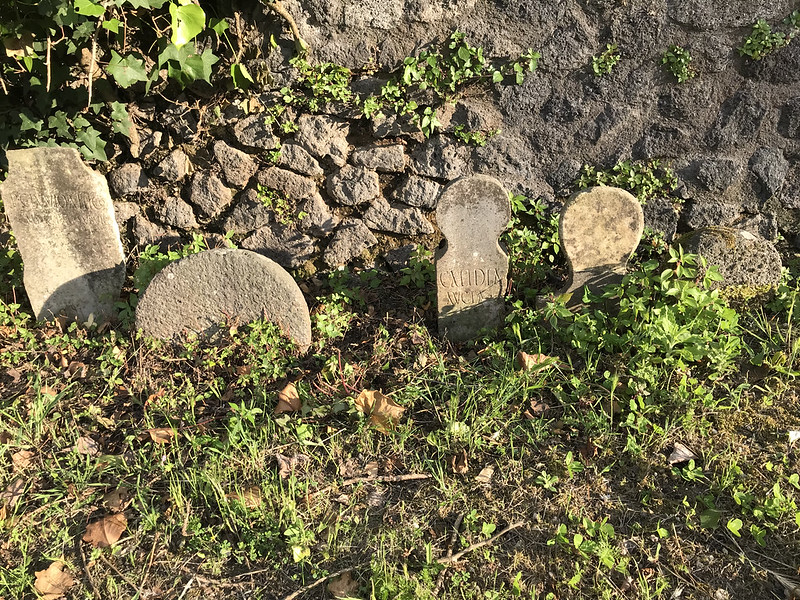In Stone and Story
Early Christianity in the Roman World
Materials available for professors by request only
Chapter 19: Banqueting & The Dead
Photo Gallery
Photos 19.1 through 19.2
These photos feature particular columellae (see also photo 16.4). A columella in the center of photo 19.1 clearly shows the name of the person it memorializes — a woman (now unknown) named Claudia Aucta. Photo 19.2 shows the columellae of two men and one woman. We know this because columellae commemorating women always are marked out by a hair bun at the back of the head, something that columella commemorating men never had.
Photos 19.3 through 19.4
Figure 19.7 of In Stone and Story shows a drawing of a triclinium in a tomb — a drawing that dated close to the time that the tomb was excavated. Since then the tomb (like most of the excavated parts of the Vesuvian towns) has been ravished by the forces of nature, causing the site to look much different today. Photo 19.3 shows what the triclinium looked like in 2015. The façade of the tomb is shown in photo 19.4. The tomb is that of Gnaeus Vibrius Saturninus (HGW23).
Photos 19.5 through 19.9
The tomb at HGW17 has a marble inscription in honor of Aulus Umbricius Scaurus, a notable civic official of Pompeii (mentioned in chapter 10 and 13 of In Stone and Story). As noted in the descriptor for figure 10.3 of In Stone and Story, archaeologists may have placed the inscription on the wrong tomb, since it had fallen off its moorings in the eruption and was found between HGW16 and HGW17. But despite the issue of who this tomb commemorated, it is a good indication of the architecture of a memorial tomb and its social configuration — including 15 niches (not all of them shown in these photos) into which cremation vessels would have been placed, and a back area for household memorial gatherings. The photos reveal:
- the façade of the tomb (photo 19.5);
- the entrance into the inner tomb, with a central space for the placement of the householder’s cremation vessel (photo 19.6);
- the left side of the inner tomb (with the photo taken from the front looking back), with four further niches for cremation vessels at the side and one more shown along the back wall (photo 19.7);
- the right side of the inner tomb (with the photo taken from the back looking toward the front), with four further niches at the side and one more shown along the front wall (photo 19.8);
- the back area of the tomb enclosure (photo 19.9), allowing just enough space for a household gathering in order to honor the deceased of the household.
Class Activities
- Have students reconstruct (or identify the “ingredients” of) a Corinthian version of the Lord’s Supper — the sort of thing that Paul challenged in 1 Corinthians 11. What were the dynamics of that meal? What different types of people did those dynamics revolve around? What forms of social relationality might have been evident in the meal? Then have students reconstruct (or imagine) what might have happened if Paul himself could have entered their meal in progress.
- Have students identify memorials that supersede the memorial of Jesus (the practice of the Lord’s Supper) in their cultural and theological importance.
Discussion Questions
- How were accolades and honorific titles made public in the ancient world? How does this compare with your own context?
- Compared with other deities (and important individuals) of the ancient world, what was different about Jesus’ deific memorialization? How was this significant for the early Christian movement?
- What similarities and differences exist between the modern observances of the Lord’s Supper and those of the first-century believers? How does Paul envision the meal, especially as it pertains to suprahuman forces? How does your context reject, reflect, or refract those suprahuman forces of the Lord’s Supper?

